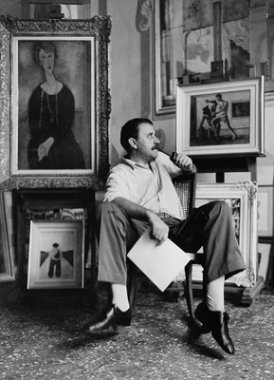Shot at the beginning of the Fifties in Palazzo Pisani, a life size-picture portrays Carlo Cardazzo with his arms leaned over Marino Marini’s sculpture of a small horse. “Cavallino”, small horse in Italian, will be the real tutelary deity of most of the dealer’s undertakings in contemporary art. That same small horse is still visible beside the door of his house in Calle dei Ragusei in Venice. The picture gives the first impression to the visitors before entering into the space of the exhibition dedicated by Guggenheim Collection to the multifaceted figure of Carlo Cardazzo (1908 – 1963) and his “new vision of art” in the centenary of his birth.
Luca Massimo Barbero spent two years researching into the “Cardazzo Universe” looking for the traces of his insightful collecting: Cardazzo was a true “manager of images”, an attentive dealer able to predict the changes in taste of his clients and to foreshadow new trends. This exhibition is a tribute to his infallible intuition that was able to recognize lively new voices of post-war Italy ready to give shape to original languages. “An authoritarian, shy and sweet giant” as curator Luca Massimo Barbero refers to him. Barbero is also the exhibition designer and created from his own project the functional wooden boxes used in the display to present prints, lithographs, rare editions’ covers and drawings. The show is able to recreate the bodily space in which Cardazzo used to move while following his futuristic vision of art.
Decorated by Boiseries of sophisticated nuances, the first small room already reveals the wise selection of pictures: on the left a small Morandi strikes the attention with its magical aura, following the portrait of Cardazzo’s son Paolo and wife drawn by Campigli with his characteristic two-dimensional and mysterious line. Inside a showcase is a small deer realized for Cardazzo by Lucio Fontana.
We are literally plunged into his vision and his passion, shaped by a vortex of encounters and fervid collaborations with all the artists that worked with him along his blazing thirty-years artistic adventure: Fontana, De Pisis, Sironi, Carrà, Capogrossi, Sinisgalli, Campigli, Dubuffet, Kline and many others. From everyone he was able to draw the best and then create a dialogue and a thick network of references and connections.
Carlo’s talent was extremely precocious, he was the son of a building contractor and began to collect pictures at very young age, as he reveals: “I started to buy some pictures in 1926, I was eighteen and probably I could have considered myself as the youngest collector in Italy. The first pictures I bought were by De Pisis. Then slowly I started to broaden my interests to include most of the Italian avant-garde of the time, basically paintings of the twentieth century: Campigli, Carrà, Sironi, Morandi and all the others”. He was a very disciplined collector, very deliberate in his taste and manners.
On the 25th of April 1942, Saint Mark’s Day, Galleria del Cavallino opens on the Riva degli Schiavoni. It was destined to become the propelling centre of contemporary art in the lagoon. Cardazzo appointed Carlo Scarpa to restore and decorate the gallery. Some transparent panels in the Guggenheim’s exhibition reveal the inner movement and wise display strategy of those spaces. The gallery is a meeting point for the young intelligentsia of the city, one would go there to learn about what is happening outside of Venice, for some of these young people it constituted a passage rite, as Luigi Nono reveals in a torrential interview with Restagno.
Four years later, driven by always-renewed enthusiasm, Cardazzo opened another gallery in Milan, Galleria “Il Naviglio”. But he was not only a dealer and a gallerist, he also experimented with different enterprises; he designed promotional objects commissioned to his artists: scarf patterns, postcards, records, lithographs, original fonts and art books’ covers.
His entrepreneur attitude was irrepressible but he never lost sight of artistic quality. He produced many beautiful small editions of artists’ book with contemporary artists’ illustrations: Il Milione by Campigli, a Jean Cocteau’s book designed by De Chirico, and Apollinaire and Georgiche designed by Marino Marini. Collaborations with writers, poets, painters, illustrators and caricaturists are so numerous that it would be impossible to recall them all, It is sufficient to think of the extremely refined small poems’ collections of the Thirties.



